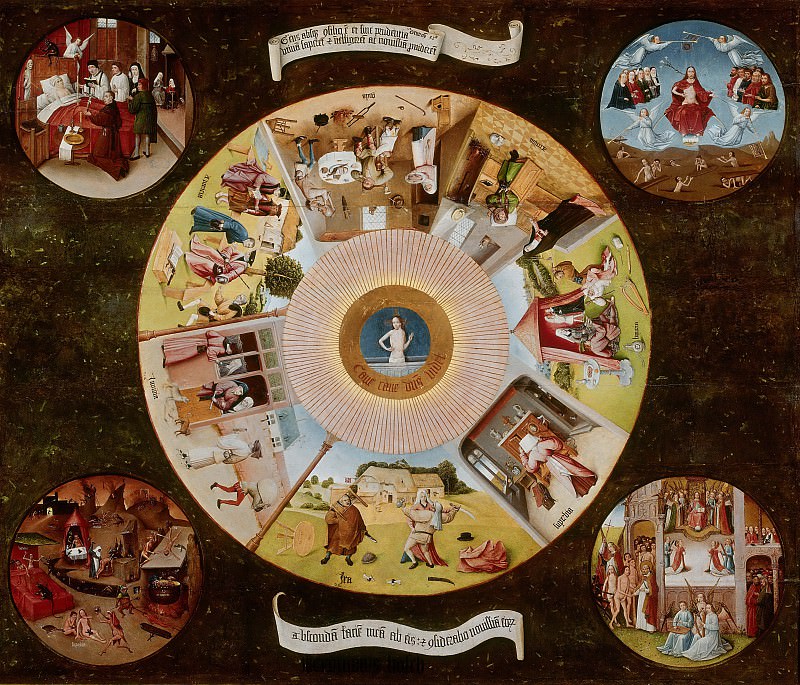The Seven Deadly Sins and the Four Last Things (workshop or follower) Hieronymus Bosch (1450-1516)
Hieronymus Bosch – The Seven Deadly Sins and the Four Last Things (workshop or follower)
Edit attribution
Download full size: 4662×3989 px (3,6 Mb)
Painter: Hieronymus Bosch
Location: Prado, Madrid.
Erun Antonison van Aken or Hieronymus Bosch. Famous Netherlandish artist of the Northern Renaissance. Twenty-five paintings and eight drawings by this painter have survived to this day. The most famous painting is The Seven Deadly Sins and the Four Last Things. Like Dante Alighieri in The Divine Comedy, who descended into Purgatory and experienced all its circles, Hieronymus Bosch recreated human sin on his canvas, according to the religious canons of his time.
Description of Hieronymus Bosch’s painting The Seven Deadly Sins and the Four Last Things
Erun Antonison van Aken or Hieronymus Bosch. Famous Netherlandish artist of the Northern Renaissance.
Twenty-five paintings and eight drawings by this painter have survived to this day. The most famous painting is The Seven Deadly Sins and the Four Last Things.
Like Dante Alighieri in The Divine Comedy, who descended into Purgatory and experienced all its circles, Hieronymus Bosch recreated human sin on his canvas, according to the religious canons of his time. The painting is painted using the artist’s favorite technique, alla prima, when the first strokes of oil paint create the final texture of the canvas.
"The Seven Deadly Sins" is a unique masterpiece of the artist. Shaped as a kind of "tabletop" (although it has never been one), painted to show man his sinful nature and philosophical edification, the painting makes an indelible impression.
Against the dark background of the canvas, a multistructured composition of five circles of different diameters is painted. At the very center is the likeness of the all-seeing eye, within which is Jesus Christ who observes all events in this world and notices all human sinful deeds. Around Jesus, counterclockwise, as originally conceived by the author, are genre scenes painted in the detailed manner of the old Dutch school of painting.
Each scene vividly demonstrates all human vices: anger - depicted as a fight between two men and a woman who had been drinking heavily before; pride - a woman staring greedily into a mirror, which served as Bosch’s favorite allegorical demonstration of vanity and pride, since it was considered an instrument of the devil. Lust - two couples in love with lust; Sloth - failure to perform his duties by the priest, to whom the parishioner came for confession; Gluttony - a fat man who devours everything on the table and cannot get enough; Greed - bribing a judge, on whose decision a person’s fate depends; Envy - expressed in the oblique glances of an elderly couple at their neighbor, who has made an expensive purchase).
At the bottom of each image there is a Latin inscription or quotation from the Old Testament (for example, under the eye of the Lord it says Cave, cave, Deusvidet - "Fear, for the Lord notices everything").
In the four corners of the painting are four circles of equal size (the so-called tondo), which complete the meaning of the picture, demonstrating the outcome of human life - death (the dying man surrounded by priests, at the head of which stands the Lady Death herself, an angel and a demon);
The Last Judgment (apostles, souls waiting for the just judgment and angels with trumpets of Jericho);
Hell (a very realistic depiction of sinners, boiling cauldrons, torture and devils) and Paradise (the Apostle Peter opens the gates to the righteous, the Most High on his throne and the saints).
Almost all of Hieronymus Bosch’s paintings are imbued with ironic sarcasm over the futility of human existence, but the painting The Seven Deadly Sins forces us to think and rethink our lives in order to make them cleaner and more spiritual.
Кому понравилось
Пожалуйста, подождите
На эту операцию может потребоваться несколько секунд.
Информация появится в новом окне,
если открытие новых окон не запрещено в настройках вашего браузера.
You need to login
Для работы с коллекциями – пожалуйста, войдите в аккаунт (open in new window).




















COMMENTS: 2 Ответы
НАШ МИР
Он пьёт коньяк, сигарой толстой
Дымя вовсю – хозяин томный
Поместья – розов особняк.
И пьётся весело коньяк.
Поэт с утра корпит над строчкой,
И грезит чёрной жирной точкой,
Что не поставить – ох, никак.
А он бы тоже пил коньяк.
Бродяга день провёл без пищи.
Копается в помойке нищий.
На службу ксёндз поехал в пять,
И чувствует: его опять
Сомнения одолевают.
И слёзы небеса роняют.
А вор планирует грабёж –
Приятен банковский пейзаж.
А клерк в обед идёт в кафе,
Щебечут цифры в голове.
Разбито,
Звякнуло стекло.
И закрутилась ругань зло.
За верстаком горбатым плотник –
До дерева большой охотник –
Трудился день, устал весьма.
Темны, коль сумерки, дома.
Пёс лает. А художник пишет.
И голоса небес не слышит
Никто.
Ни этот господин в пальто,
Ни тот, несущийся в машине
По автостраде. Ни – в помине –
В особняке сидящий – пьёт
Коньяк, не ведая забот.
часы.. заведенные в полночь..
несут в округу звон унылый..
забыли.. люди.. эх.. забыли..
что жизнь игра.. а время сволочь
You cannot comment Why?
This painting, The Seven Deadly Sins and the Four Last Things, is a didactic and allegorical work illustrating the consequences of sin and the ultimate fate of humanity. The central composition is a large circular disc, reminiscent of a target, divided into sections.
What I see:
Subtexts:
In essence, The Seven Deadly Sins and the Four Last Things functions as a visual sermon, aimed at instilling fear of sin and Gods judgment while offering the hope of salvation through a righteous life.